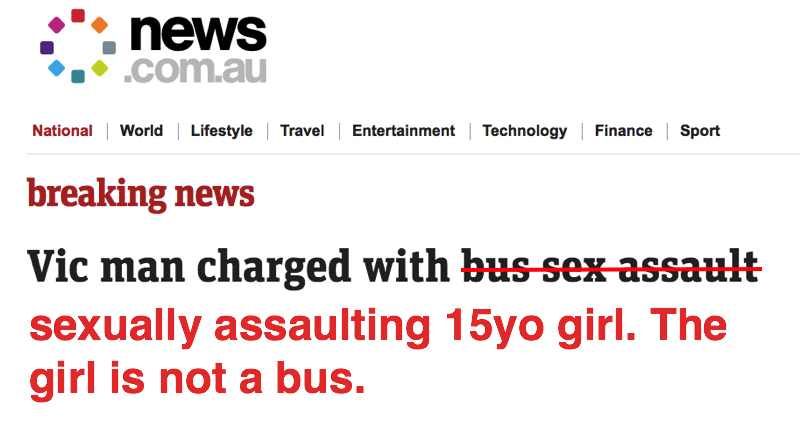News.com.au reported that a 21 year old man has been charged with sexually assaulting a 15 year old girl in Hampton Park last year.
As many people who follow FixedIt might know, one of the most common problems with headlines about men’s violence against women is the invisible perpetrator. In this case the man arrested for sexual assault is where he should be – at the front of the headline. Unfortunately the victim of the alleged sexual assault was replaced by a bus.
The alleged sexual assault may have occurred on a bus, but it was not a bus that was assaulted. It was a 15 year old girl.
The man has been charged on three counts of sexual assault. He has not been to court. This commentary is not about his guilt or innocence, which can only be determined by the court, it is about the way the charges against him are described in the media.
If you haven’t watch Jackson Katz’ TED talk on violence against women I highly recommend it. He’s talking about the general conversation about men’s violence but he perfectly demonstrates the problem with the way the media reports this stuff. I’m slightly paraphrasing his examples here, but the principle is unchanged.
We start with a very basic sentence: “John raped Mary.” John is the subject, rape is the verb, Mary is the object. Three words to describe exactly what happened.
The second sentence says the same thing in the passive voice. “Mary was raped by John.” The focus shifts from John to Mary but the sentence is still describing what happened.
The third sentence, John is invisible and all we see is that “Mary was raped” and now it’s all about Mary. John is gone and we’re wondering why Mary was raped.
“Mary is a rape victim” The last sentence has changed what John did to Mary into her very identity and John is not relevant to the conversation.
So which of these four sentences is the most accurate description of what happened between John and Mary?
It’s not that last one. Mary is not a rape victim, she’s a person. She’s Mary. People who have been raped do not become what was done to them. It does not define them. It was a crime someone else chose to commit against them.
It’s not the third one, that only tells half the story. It tells us about Mary but nothing about John. John was the one who committed the crime. The story is about the acts he chose to commit and the affect it had on Mary. If John isn’t in the headline it’s only telling half the story.
The second sentence describes the entire event but it does so in the passive voice – something we are taught in journalism 101 to avoid. In this case we are putting Mary at the front of the sentence, making her the subject and the focus, John trails off at the end.
So that first sentence, “John raped Mary” is the only one that accurately reported what happened. John is the subject of the sentence because it was his choice to commit rape and that choice is the only factor that caused the crime. That he chose to rape Mary is there and that it was rape it there. Three words is all it takes to tell you what happened.
But almost every headline about men’s violence against women is a variation of one of the other three sentences. The “John raped Mary” structure, the only one that is accurate and in the active voice journalists are always supposed to use, that’s the one you almost never see.
This is the basis for most of the work I do on FixedIt.
There’s a reason I focus so strongly on headlines. Most people don’t consume news by reading a print newspaper from cover to cover. Only some people go directly to the home page of a news outlet. Most people get news links from social media, and the most likely source is Facebook. But regardless of the source, we see far more headlines than we click on.
Something like 80 percent of the headlines we see, we never click through to read the article. We’re not necessarily thinking very much about the headlines we don’t click on, but we see them. And without being consciously aware that it’s happening they are still describing something to us. When they fit our subconscious bias or when they’re underpinned myths about violence and repeat them over and over again, they reinforce them in our minds, but we don’t really notice that it’s happening.
The things we don’t notice are far more dangerous than the things we do notice.
Headlines matter and this is why FixedIt exists.
FixedIt is an ongoing project to push back against the media’s constant erasure of violent men and blaming of innocent victims. If you would like to help fund it – even $5 a month makes a big difference – please consider becoming a Patron
1800 RESPECT
Sexual assault, domestic and family violence counselling and support.
24 hours a day, 7 days a week.
Ph: 1800 737 732
www.1800respect.org.au
Suicide Call Back Service
24 hours a day, 7 days a week.
Ph: 1300 659 467
www.suicidecallbackservice.org.au
Kids Helpline
24 hours a day, 7 days a week.
Phone: 1800 55 1800
www.kidshelp.com.au
MensLine Australia
24 hours a day, 7 days a week.
Phone: 1300 78 99 78
www.mensline.org.au
Child Wise National Abuse Helpline
Mon-Fri: 9 am – 5 pm
Ph: 1800 99 10 99





